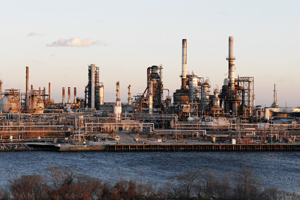ULSD Supply Woes Loom

This story appears in the March 5 print edition of Transport Topics. Click here to subscribe today.
Truckers in the Northeast soon could find ultra-low-sulfur-diesel fuel in short supply and more expensive if Sunoco Inc. proceeds with its plan to close its Philadelphia refinery in July, the U.S. Energy Information Administration warned last month.
Editor’s note: Diesel rose 4.3¢ to $4.094/gal., DOE reported March 5.
Sunoco, looking for a buyer for the refinery, has said it will close the 330,000-barrel-per-day facility if none is found.
If Sunoco shutters the plant, it would be the third refinery closing in southeast Pennsylvania since September — representing 50% of the total refining capacity in the Northeast — said the agency, which is part of the U.S. Department of Energy.
“The additional loss of volumes and reduced access to distribution systems may create temporary, localized shortfalls and associated price surges,” EIA said in its report.
Northeast refineries usually have supplied about 60% of the ultra-low-sulfur-diesel fuel consumed in the region. The rest comes from Gulf Coast refineries and imports, EIA said.
ULSD also is refined in the Gulf and Midwest, but because there’s not much excess pipeline capacity to move the product, fuel to the Northeast might have to be shipped by rail, said John Felmy, chief economist at the American Petroleum Institute.
If Sunoco’s Philadelphia refinery shuts down, suppliers may need to find 180,000 more barrels per day of low-sulfur diesel by 2013, the agency said. And logistical constraints on product delivery to certain areas of the Northeast may present additional challenges, EIA warned.
Sunoco said in September that it was exiting the refining business because of rising costs and low profit margins.
“We’ve lost $900 million in the past three years, and that’s just not sustainable,” Sunoco spokesman Thomas Golembeski told Transport Topics. “This threatened the viability of the company, and we had to make a difficult choice between continuing refining and putting the company in jeopardy, as well as the 7,000 nonrefining jobs we offer.”
Also in September, ConocoPhillips Co. idled its 185,000-barrels-per-day Trainer refinery south of Philadelphia. Two months later, Sunoco shut its 178,000-bpd Marcus Hook refinery, also south of the city.
ConocoPhillips closed its refinery because of high maintenance costs and overseas competition, spokes-man Rich Johnson said.
“Those refineries have been losing money because they’re tied to Brent crude, which is more expensive than West Texas Intermediate, and because of weakened demand for gasoline,” said API’s Felmy.
In another blow to the Northeast, Hovensa LLC closed its 500,000-bpd refinery in St. Croix, U.S. Virgin Islands, in February. Hovensa, a joint venture of Hess Corp. and Petroleos de Venezuela S.A., also supplied the East Coast with fuel.
Hovensa blamed weak demand for refined petroleum products and additional refining capacity for its losses of $1.3 billion on the St. Croix refinery over the past three years.
“There is potential for shortages, obviously, and there could be price differentials,” said Glen Kedzie, energy and environmental counsel at American Trucking Associations. “But there’s enough lead time for contingency plans to be developed.”
The closings of Trainer, Marcus Hook and Hovensa have been offset partially by the startup of PBF Energy’s 190,000-bpd Delaware City refinery in October 2011. The facility had been shut down in late 2009 by Valero Energy Corp. before its sale to PBF Energy.
But it’s the closing of Sunoco’s Philadelphia refinery that has most analysts on edge.
“If you live in the East Coast, you should be very, very worried. They have lost 60% of their refinery capacity,” said Phil Flynn, senior market analyst for PFGBest in Chicago. “The East Coast relies now more on imports than ever before,” he said. “Any type of global disruption, and they may be held hostage.”
In a statement, Sunoco said there is overcapacity in the refining industry.
Sunoco’s Golembeski said that with 2 million barrels per day of refining capacity — equivalent to a dozen Marcus Hooks — being added every year, it does not make sense to compete with imported petroleum products or overseas refineries.
Sunoco’s Philadelphia refinery processes light sweet crude, but the facility cannot refine other types, Golembeski said. Because light sweet crude is easier to refine into low-sulfur diesel, gasoline and kerosene, it is popular and more expensive than other crudes.
Felmy added it’s also possible that the idled refineries could become oil terminals, although this prospect would require extensive environmental reviews. Also, barges and tankers supplying the terminals would have to operate under the Jones Act, which prohibits foreign-flagged vessels from operating in U.S. coastal waters.
There is some buyer interest in the Philadelphia facility, Golembeski said, but he said his company didn’t receive a single proposal to keep Marcus Hook open as a refinery, and the company is now mulling alternative uses for that site.
The Philadelphia refinery includes refineries at Point Gerard and Point Breeze, which Sunoco bought in 1984 and 1988, respectively. The company merged them in 1995.




